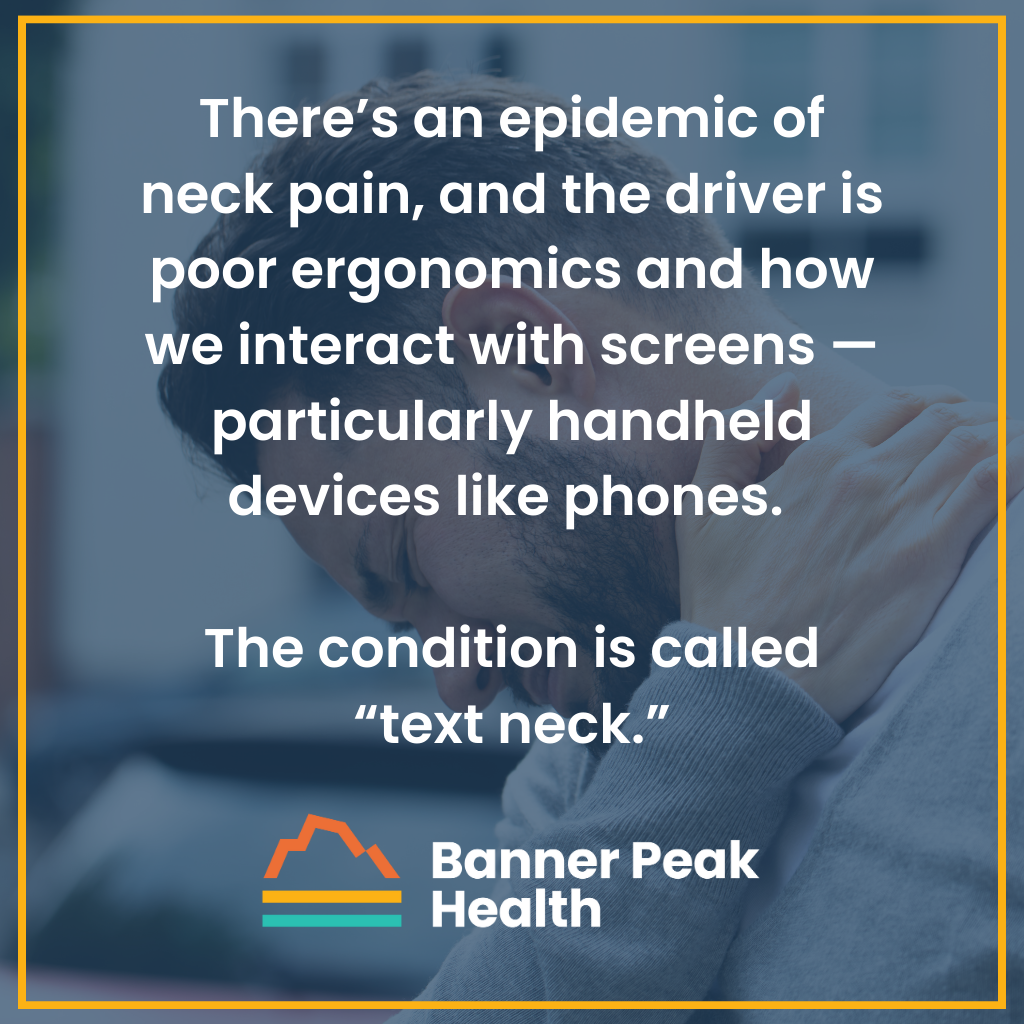Everyone’s heard the mantra of the “core,” defined as the lower back, hips, pelvis, and stomach. We all know the core is essential for movement and athletic performance.
But what about the north core?
Never heard of it? I’m not surprised.
What I define as the “north core” is the group of muscles surrounding your neck. Unfortunately, the neck is the forgotten part of the spine.
In my opinion, we focus too much on the main core — that anatomy is extremely solid. We really haven’t focused on the ergonomics and protection of the north core, even though those muscles give the neck strength and flexibility.
The seven cervical vertebrae are tiny, and we aren’t conscious of the surrounding muscles… that is, until the pain of text neck starts.
The Neglect of the North Core
Neglecting the neck can lead to a domino effect of symptoms in our musculoskeletal system.
When we ask our muscles to perform tasks they simply can’t do, they become stretched and inflamed. They spasm. As they spasm and contract, they create tension in adjacent muscle groups.
What starts as overuse of a small group of paraspinal cervical muscles turns into trapezius spasms, shoulder pain, and headaches. And it’s all driven by overuse of these little muscles.
To prevent a pain syndrome cascade, we need to better protect and be conscious of our cervical muscles.
Let’s Talk About Text Neck
There’s an epidemic of neck pain, and the driver is poor ergonomics and how we interact with screens — particularly handheld devices like phones. The condition is called text neck, and recent studies show astounding results.

The average human head weighs 10–12 pounds. As you tilt your head forward, you increase the force applied to the base of your neck.
As you can see in the graphic, even slight increases in tilt angle drastically increase the amount of force transmitted to your neck. By the time your head is tilted to a 45-degree angle, the force on your neck has increased fivefold!
Heavy is the head that stares at the phone.
Imagine the effect of this amount of sustained pressure over hours every day. Voilà — text neck!
What if We Ignore Text Neck?
Who doesn’t have neck pain?
My best friend once asked me to refer him to a good acupuncturist because his neck was killing him. I told him I’d refer him to a good acupuncturist if he promised to stop resting his laptop on his chest while he used it in bed.
Don’t put a Band-Aid on a bullet hole. There’s no reason to provide a small, momentarily effective treatment if you don’t do anything to address the root cause of the problem.
As I mentioned earlier, the issue with neglecting your north core is the domino effect it can cause throughout your musculoskeletal system. Overuse leads to stretching and inflammation, which leads to spasms, which leads to pain in the neck, which migrates to the shoulders and back and causes headaches.
Simply put, it’s not just about neck pain.
Stop Blaming Your Pillow for Text Neck
Often, patients ask me what the best pillow is for neck pain. When I ask why, they tell me they wake up every morning with terrible neck pain and insist it must be their pillow.
Let me assure you — it’s not your pillow’s fault.
The mechanism for generating the pain you woke up with is the muscle you overused the day before, the inflammatory process that set up overnight, and the spasm you woke up with. Just because you woke up in pain on your pillow doesn’t make it your pillow’s fault.
What We Can Do About Text Neck
First, we must be aware that text neck syndrome is real and common. The signs are frequent neck pain, headaches, shoulder pain, and pain anywhere from the top of your head to your armpit. The problem is widespread, and we need to address it.
Amazingly, there’s an app for that!
Some brilliant people have found a way to use a smartphone’s motion sensor to determine the angle at which the phone is being held. The app alerts the user with a red light when the angle of view is too severe.
Using tools like this can significantly improve your posture during device use and reduce your risk of developing text neck. Taking advantage of voice-to-text functions and voice assistants like Siri and Alexa more often can also help.
Finally, you can improve your range of motion and alleviate pain by stretching regularly. Since pain is caused by muscle spasms and tightness, stretching those muscles can help reduce pain and prevent further damage.
Today’s Takeaways
- Your “north core” deserves just as much attention as your main core.
- Text neck is real and incredibly common.
- A new pillow won’t solve the problem. Instead, try posture-improvement apps, voice-to-text assistance, and stretching exercises to improve your north core strength and prevent text neck.

Barry Rotman, MD
For over 30 years in medicine, Dr. Rotman has dedicated himself to excellence. With patients’ health as his top priority, he opened his own concierge medical practice in 2007 to practice medicine in a way that lets him truly serve their best interests.




